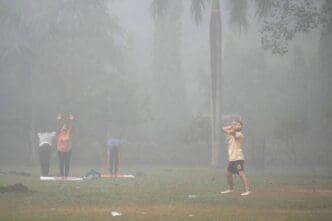In New Delhi, residents faced a grim reality as air pollution surged to unprecedented levels, prompting immediate government intervention.
On Monday, New Delhi authorities implemented emergency measures as the city’s air quality plummeted to hazardous levels. The government’s response included shutting down schools, halting construction activities, and banning non-essential trucks from entering the city. These actions were a part of stage 4 of a graded response action plan designed to curb pollution.
The capital, home to around 33 million people, was enveloped in thick, toxic smog, with visibility severely reduced. The System of Air Quality and Weather Forecasting and Research (SAFAR), India’s main environmental monitoring agency, confirmed that pollution levels had exceeded 50 times the safe limit recommended by the World Health Organization.
Airlines warned travelers of potential delays due to the dense haze obscuring landmarks and high-rise buildings. Despite such warnings, many residents continued their daily routines, braving the toxic air for morning walks and commutes.
The severe air pollution was primarily attributed to several factors. As winter approaches, farmers in surrounding states traditionally burn crop residue, a practice that significantly contributes to air pollution. This period also coincides with cooler temperatures that trap pollutants close to the ground. Additionally, vehicle emissions and industrial activities in and around the city add to the deteriorating air quality.
Public concern has been growing, with many residents taking to social media to express their frustration and demand action. Descriptions of the city as a “gas chamber” emerged, along with reports of common health issues like sore throats, headaches, and coughing among the populace.
Long-term solutions to New Delhi’s air pollution problem remain a contentious issue. Critics argue that temporary measures such as deploying water sprinklers and banning certain vehicles are insufficient. There is an urgent call for sustainable solutions that address the root causes of pollution, rather than just its symptoms.
Sanjay Goel, a local shopkeeper, voiced a sentiment shared by many: “They should ban crop residue burning … it’s just smoke everywhere.” This reflects the broader public demand for decisive action to prevent severe pollution spikes in the future.
Despite the toxic environment, many inhabitants of New Delhi have shown resilience by adapting their lifestyles to cope with the adverse conditions. However, the ongoing situation highlights the pressing need for comprehensive strategies to tackle pollution effectively.
The smog in New Delhi serves as a stark reminder of the urgent need for effective environmental policies. Without sustainable solutions, the capital’s air quality crisis will likely persist, affecting millions of residents.
Source: Sun-sentinel








